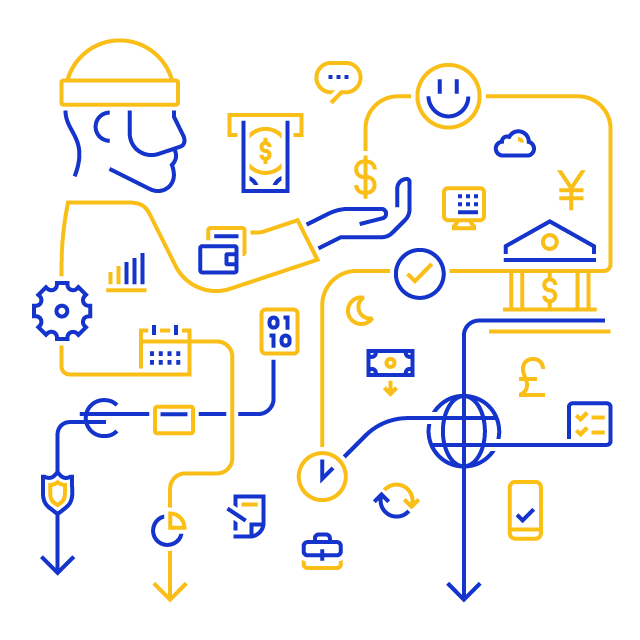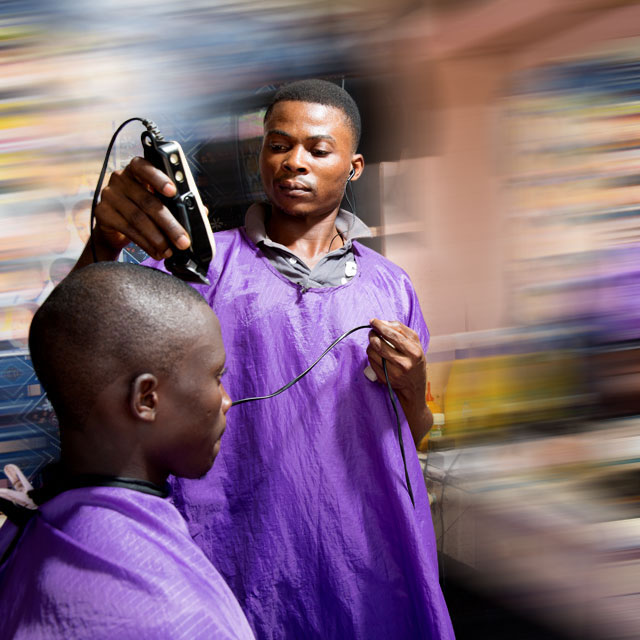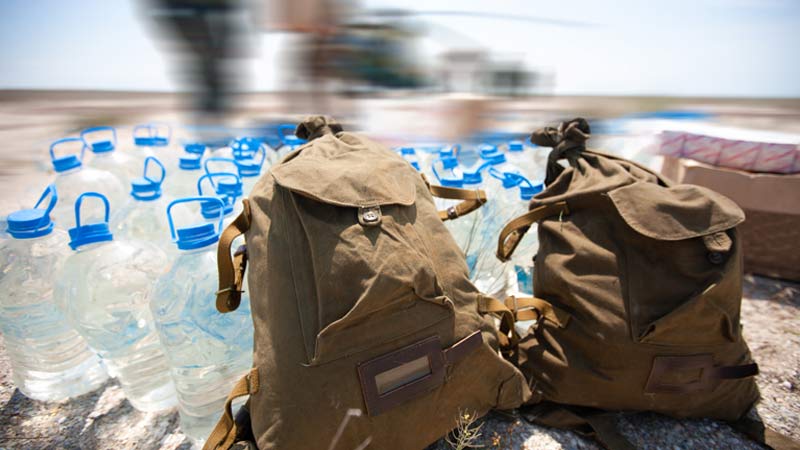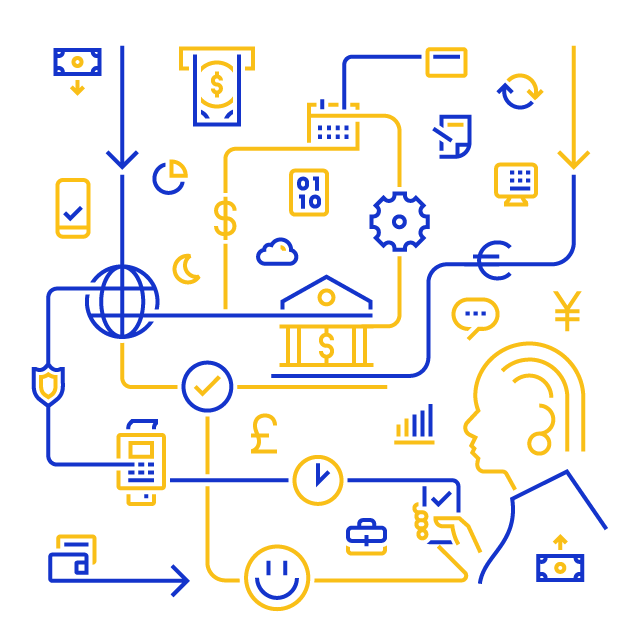Money movement transformed
Many decades ago, Amir landed his first job working in a gleaming Singapore high-rise. He was in the accounting department for a large multinational corporation that had just opened its first office in the island nation, and Amir had moved a few hundred miles from his home in Malaysia to take the job. He was making more money than before, but a long way from home and his family. He was thankful to be able to send a portion of his paycheck home every month to support them; so, every month, Amir would write a credit note, hand it off to a courier on a bus headed for his hometown, and hope for the best.
It was a nerve-racking experience. Amir didn’t know whether the money made it home safely until his mother called him, and he spent the intervening time worrying about whether his family would have enough money to buy groceries and see doctors. Amir would often stay by the phone for hours on the day he knew the bus would arrive home, sometimes falling asleep until the phone rang and jolted him awake.

Times have changed since Amir first started sending remittances home all those years ago. Now he can send money from Singapore to his family in rural Malaysia¹ in real-time² with a few taps on his smartphone. New systems and players are entering the remittance market, from upstart fintechs who are catering to a rapidly modernizing customer base to centuries-old transfer services that are combining their experience and expertise with groundbreaking technology. Now, people are able to send money around the globe by pressing a few buttons with transfers happening in real-time² thanks to the power and network of Visa Direct. Visa Direct is able to facilitate the transfer of money across borders¹ in real-time² between remitters and recipients.
“Remittances are about connecting people. From day one of arriving in a new country, you want to feel connected to relatives and friends,” says Jairo Riveros, Managing Director for the Americas at the remittances platform, Paysend.
The remittance market is also growing, both in size and complexity. It’s not just workers sending home portions of their paychecks every month; rather, people are helping loved ones pay for medical procedures and emergency bills, paying for their children’s tuition and expenses at international universities, investing in international businesses and real estate, and helping to support those impacted by natural disasters and conflicts.
Remittances are about connecting people. From day one of arriving in a new country, you want to feel connected to relatives and friends.
–Jairo Riveros, Managing Director for the Americas at the remittances platform, Paysend
But it’s how the growth is happening that marks a turning point. Remittances are increasingly digital,³ with individuals able to send money straight to recipients’ cards, mobile devices, and digital wallets. Remittances senders initiated 2% of all remittances from a mobile device in 2019, and those cross-border payments totaled more than $14b.⁴ With the ubiquity of smartphones and other connected devices, that number is likely poised to grow.
Consumer demand is part of the driving force behind those changes, and new services and experiences will have to be developed in order to match those preferences. “When we talk to our customers, more of them are going the digital route because of convenience,” says Dipesh Mehta, who leads product management for regional growth strategy at MoneyGram. “The ease of use of just sending money to a person's wallet and using that wallet to go grocery shopping is important to the communities on the receiving end.”
And consumer priorities go beyond convenience as well. Speed, transparency, and security are increasingly on consumers’ minds as they look for remittance solutions in a connected world. “Digital remittances tackle the three major pain points of remittances right now: speed, cost, and ease,” says Riveros. The result is a remittance infrastructure that gives people a low-cost way to send and receive money in ways that work for them, around the world.

A thread between people
At both ends of every remittance transaction, there are two people. Remittances are threads that connect communities and individuals, and those threads are as varied and diverse as the people on either side of them.
The dominant image of a remittance is a worker sending a portion of their paycheck back home to support their family, but that’s only one facet of a complex and nuanced system of cross border payments. Families sending their children off to international universities transfer money internationally in the form of tuition and allowances. Expats living abroad who need cross-border access to their pensions use remittance services to transfer money from their home country to their country of residence. People paying for a mortgage on a home in another country also send money across borders.
Those international flows of money are all vital to the global economy and increasingly facilitated by digital solutions from established cross border payment platforms like MoneyGram and Western Union as well as fintech startups like Remitly and Paysend—all of which are enabled by Visa Direct. Those platforms now allow people to send and receive money directly from their accounts through debit credentials, a system that measures the ability to transfer money in real-time,² not in days.
How fast you can access those funds is crucial for people as well. In one case, Remitly helped a customer send money home to pay for an emergency medical procedure his mother needed.⁵ “The customer sent the money to an eligible Visa debit card, because it's a fast experience,” says Nick Moiseff, EVP of North America for Remitly. “The funds were in his mom's account in India quickly and she was able to get her surgery.” Because he was able to fund the transfer in real-time² with his card and direct the payment to his mother’s Visa debit card number, the funds were routed into her account in real-time.²
Thanks to these digital solutions, new remittance corridors will start to emerge and mature as well. People in developed countries sending money to developing ones represent only a part of the global cross-border flow of money. Intraregional transfers like those within sub-Saharan Africa are some of the most expensive in the world and present a crucial problem for remittance platforms to address.⁶ “A worker who sends money from Argentina to Bolivia or Colombia to Venezuela sometimes has to send money through human couriers and that’s expensive and risky,” says Riveros. Those regional markets still don’t see the same volume as massive corridors like the United States to India or Italy to Nigeria,⁷ but with the rise of digital remittances, people in those areas are finally seeing the beginnings of more affordable cross-border money movement.
The customer sent the money to an eligible Visa debit card because it’s a faster experience. The funds were in his mom’s account in India fast and she was able to get her surgery.
–Nick Moiseff, EVP of North America for Remitly

Remittances are more than money – they’re a lifeline
There are few things more frustrating than knowing someone you care about is in trouble and being unable to help. That’s often the case for expats during emergencies when cross-border transfers are critical. You’re driven to help but unable to figure out the best way to get money and resources into the hands of the people who need it most as they may be unable to access financial institutions.
Did you know?


Remittance platforms recognize how indispensable having access to money is in the midst of a disaster, especially when the usual avenues of money movement are cut off. “When there are these natural disasters, our customers need funds that their government isn't able to get to them, so they rely on families abroad,” says Moiseff. “Being able to make sure that more of that money makes it home and at times when they need it most is particularly important.”
Protecting that vital flow of money is also paramount, and Visa Direct has been able to help companies give remitters an understanding of where their money is as well as help provide peace of mind. “Visa is a stamp of quality, security, and assurance that funds are going to get to their loved ones,” says Andrade.
The frustration, fear, and helplessness of seeing friends, family, and communities impacted by conflict and natural disasters thousands of miles away isn’t something that can be solved easily. But remittances can provide that essential connective tissue between individuals when they can’t be together, and by making remittances fast, secure, and convenient, remittance companies and Visa are helping to create a world where helping those you care about can happen in a few taps on a smartphone.
Visa is a stamp of quality, security, and assurance that funds are going to get to their loved ones.
–Breno Andrade, VP Visa Direct for Latin America and the Caribbean
Towards a better remittance future
Remittances may be digitizing, but their importance is still deeply rooted in personal relationships. At both ends of a payment—whether it’s done from a card or mobile wallet—are two people creating a bond when they can’t be together.
As those digital remittances continue to grow, international policy frameworks will need to be modernized and streamlined in order to adapt to the digital remittance landscape. Policymakers should understand that the opportunities for the next generation of remittances represent a lot more than just convenience – they can be lifelines for populations in crisis. “Creating an enabling policy environment, promoting the digitization of payments, and further broadening access to formal accounts and financial services among women and the poor are some of the policy priorities to mitigate the reversals in development from the ongoing overlapping crises,” World Bank Group President David Malpass said recently when asked about the surge in remittances during the pandemic.¹¹
The technology will have to keep up as well. The majority of remittance receivers are still picking up their money in cash, a phenomenon that adds an estimated 1%-3% cost to every transaction.¹² There are also still 1.4 billion¹³ unbanked adults who could benefit from a more robust direct-to-card and digital wallet model so that remittances can go straight to a debit or credit card and be quickly used. By providing multiple payment endpoints for users—from accounts to cards to digital wallets—Visa Direct helps remittance providers get money into the hands of people in the way that works best for them and leave fewer people out of the global financial system.⁵



“Digital wallets are getting increasingly important,” says Dipesh from MoneyGram. “There are places that we operate where a lot of times there are long lines that could take up to two or three hours to pick up money. So instead, we’re working to create a system where people can send money to digital wallets, and then recipients are able to actually use their digital wallets to buy groceries or transfer that money to a bank account.”
Payment flows will continue developing within and between regions, and as consumer demands progress globally, the infrastructure powering remittances needs to mature as well. Visa Direct is helping to create that network of the future by enabling real-time² money movement in more than 190 countries, and companies like Remitly and Paysend are creating more convenient and affordable options for users around the globe—a goal that is at the heart of both companies’ missions.
Digital wallets are getting increasingly important. There are places that we operate where a lot of times there are long lines that could take up to two or three hours to pick up money. So instead, we’re working to create a system where people can send money to digital wallets, and then recipients are able to actually use their digital wallets to buy groceries or transfer that money to a bank account.
–Dipesh Mehta, Regional Growth Strategy at MoneyGram
"People work extremely hard for their money and will sacrifice their own discretionary spending in order to send money back home as promised," says Moiseff. "We have come a long way as an industry to make remittances more transparent and trusted, and a better value for customers, but there's still more we can do." Digital remittances have the chance to shrink those fees so that more money ends up in the hands of the people that need it. For instance, digital remittances are nearly 2% cheaper than cash remittances,¹⁴ which can be a significant savings for those sending money cross-border on a regular basis. And because that money is able to be sent directly from cards and mobile devices, funds are available in real-time.²
Empowering the remittance landscape to be faster, more secure, more transparent, and less costly is all central to Visa’s mission of financial empowerment—but much more still needs to be done by policymakers, remitters, and global financial institutions. Remittances are a lifeline for billions of people around the world, and there is an urgent need to make them faster, cheaper, and more accessible. Building a remittance network that works for the people that need it is vital. The old image of remittance flows is fading away, and a new digital landscape is taking its place.
More Visa Direct thought leadership
Read more about global money movement, evolving digital payments trends, and Visa Direct clients
Footnotes
This article was published in December 2022.
- Availability varies by market. Please refer to your Visa representative for more information on availability.
- Actual fund availability depends on receiving financial institution and region.
- GSMA, State of the Industry Report on Mobile Money 2021. https://www.gsma.com/mobilefordevelopment/wp-content/uploads/2021/03/GSMA_State-of-the-Industry-Report-on-Mobile-Money-2021_Full-report.pdf.
- State of the Industry Report on Mobile Money 2021. GSMA. https://www.gsma.com/mobilefordevelopment/wp-content/uploads/2021/03/GSMA_State-of-the-Industry-Report-on-Mobile-Money-2021_Full-report.pdf.
- Use cases are for illustrative purposes only. Program providers are responsible for their programs and compliance with any applicable laws and regulations.
- World Bank. “Defying Predictions, Remittance Flows Remain Strong During COVID-19 Crisis. https://www.worldbank.org/en/news/press-release/2021/05/12/defying-predictions-remittance-flows-remain-strong-during-covid-19-crisis.
- Migration Policy Institute. Bilateral Remittance Flows. Available at https://www.migrationpolicy.org/programs/data-hub/charts/bilateral-remittance-flows.
- Remittance Prices Worldwide Quarterly. The World Bank. 2020.
- A WAR IN A PANDEMIC, Implications of the Ukraine crisis and COVID-19 on global governance of migration and remittance flows Migration and Development Brief 36, May 2022.
- The Global Knowledge Partnership on Migration and Development (KNOMAD) Remittance Data. (Available at https://www.knomad.org/data/remittances).
- COVID-19 Drives Global Surge in use of Digital Payments https://www.worldbank.org/en/news/press-release/2022/06/29/covid-19-drives-global-surge-in-use-of-digital-payments.
- The Word Bank Group, Remittances Prices Worldwide. June 2022.
- COVID-19 Boosted the Adoption of Digital Financial Services. https://www.worldbank.org/en/news/feature/2022/07/21/covid-19-boosted-the-adoption-of-digital-financial-services.
- World Bank. “Remittance Prices Worldwide Quarterly.” Issue 42, June 2022. https://remittanceprices.worldbank.org/sites/default/files/rpw_main_report_and_annex_q222.pdf.